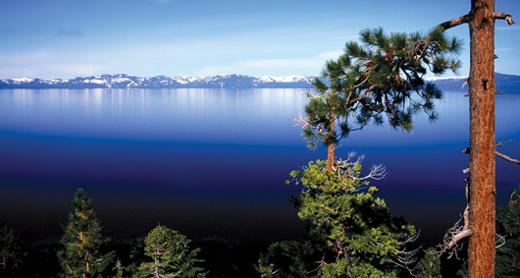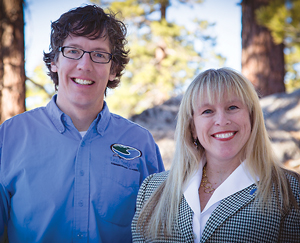
True Blue
Dedicated environmentalists work to preserve Lake Tahoe
ALUMNI | Blue runs deep, Julie Regan likes to say. The 1989 UD graduate is referring not only to her feelings about her alma mater but also to her work in helping to protect the blue waters of one of the world’s deepest lakes.
Regan, AS89, and Kevin Prior, BE97, have each been working for nearly a decade at Lake Tahoe, a spectacular tourist attraction that—with a depth of 1,645 feet—is the second deepest lake in the U.S. (after Crater Lake) and 11th deepest in the world. Twelve miles across and 22 miles long, Tahoe holds 39 trillion gallons of water on average.

Nestled high atop the mountains of the Sierra Nevada, the lake straddles the California-Nevada state line. Its bi-state geography is the root of the culture of the place—collaboration is the name of the game at Tahoe, Regan says, and she and Prior, working for two key public agencies, are part of the collective effort to restore the lake’s world-famous clarity. Tahoe is considered “ultra-oligotrophic,” which means it is transparent and has little biological activity, and is designated as “Outstanding National Resource Water” under the federal Clean Water Act.
Today the lake is so clear, you can see down 75 feet into its cerulean waters. But in the 1960s, you could see 100 feet down. Therein lies the restoration challenge, Regan says.
“Lake Tahoe is truly one of the most spectacular places on the planet,” she says, “and working to protect it is both a privilege and a challenge.” Since December 2003, Regan has worked for the Tahoe Regional Planning Agency, the nation’s first bi-state environmental agency with land use authority. The California-Nevada organization, sanctioned by Congress, sets development limits for all private properties within the Tahoe watershed, which consists of two state and six local government jurisdictions.
Environmental initiatives to save the lake also involve the federal government, which is the largest landowner in the Tahoe Basin and, through the U.S. Forest Service, manages more than 75 percent of the land there. And in addition to the various levels of government, there are millions of visitors from around the world, 54,000 residents and active coalitions of environmentalists, property rights advocates and business owners with a stake in the issue.
“When I first started working at the Tahoe Regional Planning Agency [TRPA], I was stunned to see the level of interest in our environmental sustainability programs from around the globe,” Prior says.
Regan, who is chief of external affairs, has risen through the ranks of TRPA to its senior management team. She recalls when the agency hired Prior as controller and she realized he was a fellow Blue Hen: “There just aren’t that many of us out here, so I definitely took notice and was delighted to get to work with a fellow East Coaster,” she says.
After four years at TRPA, Prior moved on to work at another agency dedicated to restoring and preserving the lake, the California Tahoe Conservancy, where he currently serves as the chief administrative officer.
Juliet Dee, associate professor of communication, recalls Regan’s work as her teaching assistant in the late 1980s. “I’m not surprised to hear she’s putting her strategic communications skills to work to save a national treasure,” Dee says. “My students loved her because she was a natural leader; she brought so much originality and creativity to her work, which I think has propelled her to this important post at Tahoe.”






